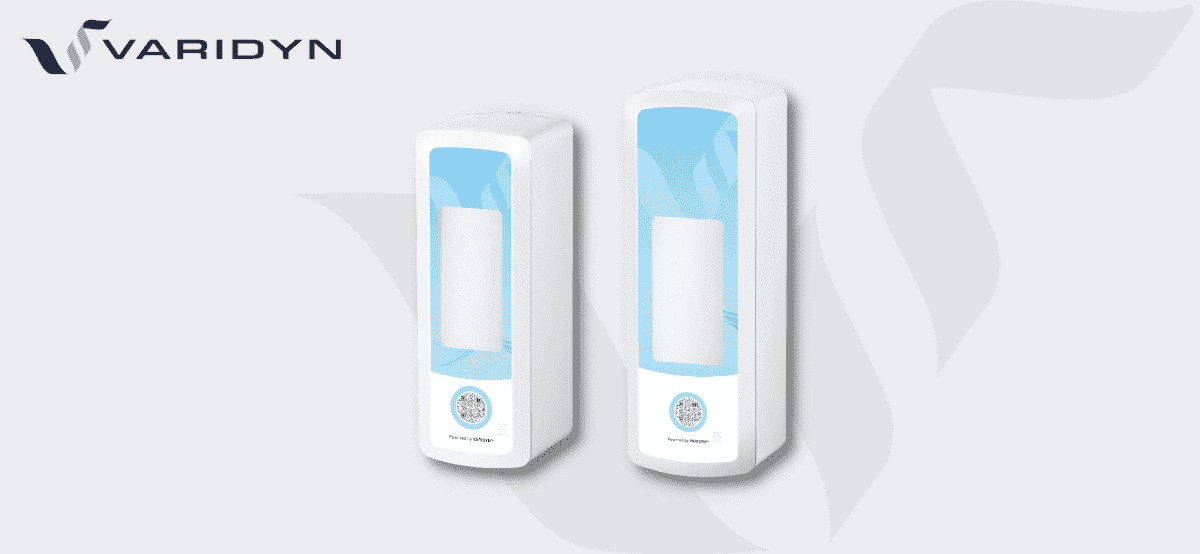The use of good hand hygiene practices in healthcare facilities reduces pathogens that lead to disease, which helps staff and patients stay safe.
The CDC recommends that people in most healthcare settings use alcohol-based hand sanitizers as the primary method for hand hygiene. Many hand-sanitizing products are dispensed from traditional automatic dispensers that get clogged and break down easily. However, the Hand Hygiene Monitoring System (HHMS) by Varidyn offers far more benefits in terms of infection control due to its superior features, including a user-friendly online portal and downloadable reports that monitor compliance.
What Is the Hand Hygiene Monitoring System by Varidyn?
The HHMS provides healthcare facilities with real-time data and reporting on hand hygiene compliance. Hospitals and healthcare organizations that switch from traditional hand sanitizing systems to the HHMS see reductions in costs of visual observation, 26% fewer days of antibiotic treatment in hospitals, and a 28% decrease in HAIs.
The HHMS meets requirements set by the LeapFrog Group, a non-profit organization that holds healthcare facilities to high standards in terms of quality and safety.
Some requirements of the Leapfrog Hand Hygiene Standard include:
- Collecting hand hygiene compliance data on at least 200 hand hygiene opportunities per month in every patient care unit
- Providing hand hygiene education and training to all healthcare workers who work with patients
- Evaluating and assessing hand hygiene practices among healthcare workers
- Analyzing and sharing hand hygiene compliance data with leadership and staff members
The HHMS vs Traditional Hand Sanitizer Dispensers
Compared with traditional hand sanitizer dispensers, the HHMS has features that deliver high ROI as they can save healthcare facilities plenty in costs related to maintenance and replacement.
Batteries in traditional hand sanitizers typically wear down quickly and need to be replaced often. They feature no alert system to notify healthcare workers when they require replacement. Their design also leads to frequent clogging and refills, which can leave many healthcare workers without access to sanitizer when they need it the most.
In a study published in a 2015 issue of the American Journal of Infection Control, researchers evaluated how the use of sanitizer dispensers correlated with staff compliance in a U.S. Midwestern hospital. They discovered that hand hygiene compliance was influenced by the visibility and accessibility of dispensers—indicating that sanitizer location was critical for improving hand hygiene.
The usability of traditional hand sanitizers cannot be tracked and monitored. In comparison, the online portal that comes with the HHMS by Varidyn allows hospitals to track which dispensers are being used the most and which are being used the least, and this data allows them to make changes leading to better compliance, visibility, and accessibility.
Additional Benefits of Switching to the HHMS
The HHMS also provides data on how often it is used and when it needs to be refilled. This system can help prevent instances in which sanitizer dispensers become empty in high-traffic areas or lose battery power, which in turn decreases the risk of spreading bacteria and pathogens.
Varidyn’s HHMS is available as a free-standing or wall-mounted unit and comes in sizes of 750 ml and 1,250 ml. It has anti-drip and anti-clog features that reduce product waste and potential damage to floors from drips. This dispenser works with both foam and gel sanitizers to support the needs of various healthcare departments and organizations.
Varidyn has everything you need to accomplish your disinfection goals so you can keep your staff, patients, and visitors safe—including NoJerm privacy screens and medical curtains. Call Varidyn at 800-827-3035 today to receive more information about our many products and services, including our HHMS.
Works Cited
- Centers for Disease Control and Prevention. “Hand Hygiene in Healthcare Settings.” 28 Jul. 2022, https://www.cdc.gov/handwashing/handwashing-healthcare.html. Accessed 9 Feb. 2023.
- Cure, Laila & Van Enk, Richard. “Effect of hand sanitizer location on hand hygiene compliance.” American Journal of Infection Control, 1 Sept. 2015, https://pubmed.ncbi.nlm.nih.gov/26088769/. Accessed 9 Feb. 2023.
- LeapFrog Group. “Factsheet: Hand Hygiene.” 1 Apr. 2020, https://ratings.leapfroggroup.org/sites/default/files/2020-08/2020-Hand-Hygiene-Fact-Sheet.pdf. Accessed 9 Feb. 2023.
